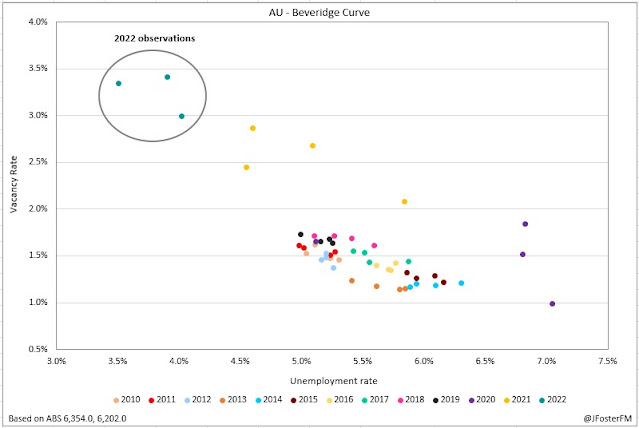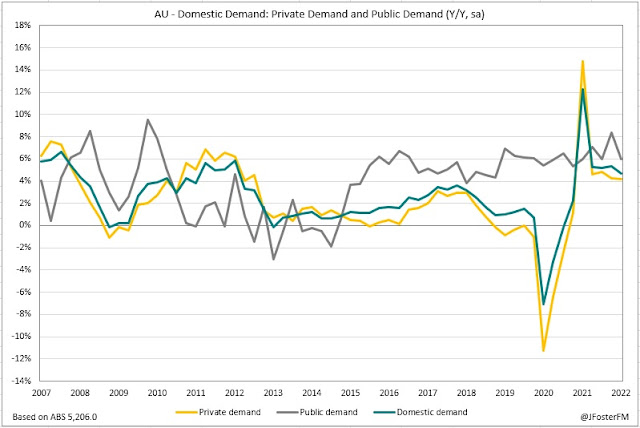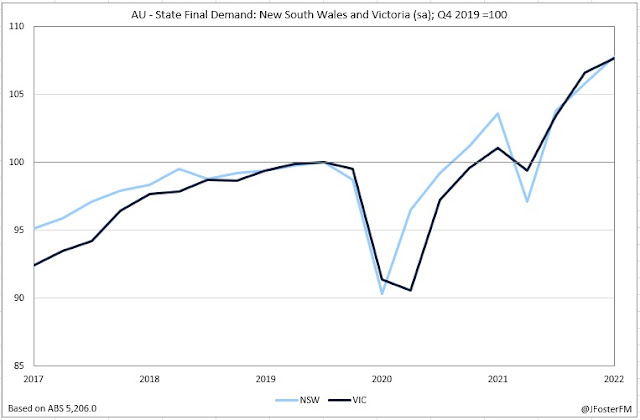— — —
National Accounts — Q2 | Expenditure: GDP (E) 0.8%q/q, 3.4%Y/Y
Household consumption (2.2%q/q, 6.0%Y/Y) — Australian household demand remained resilient, continuing to rise despite real incomes falling in response to high inflation, the RBA hiking rates and weak sentiment. A strong labour market, accumulated savings and the easing of remaining Covid restrictions have helped to defy these headwinds, lifting household consumption to a 2.2% rise in the quarter and by 6% in year-ended terms.
Consumption growth was driven by services categories (3.6%) as spending patterns continued to rotate back from goods (-0.1%). Although this rotation is occurring at pace, goods consumption (9.9%) remains substantially more elevated than services (3.3%) relative to their respective pre-Covid levels.
The reopening of the international border and increased travel domestically drove transport services to a 37.3% rise in the quarter, which led to an associated boost in spending at hotels, cafes and restaurants (8.8%q/q). Larger attendances at public events and increased gambling activity pushed up recreation services by a further 3.6%q/q. Consistent with Australians going out and about more often, demand for clothing and footwear continues to lift (3.7%q/q) and is up by more than 20% over the year, going against the broader rotation in spending away from goods.
Household incomes continue to be supported by the strong labour market. Wage incomes lifted by 2.3% in the quarter, driving a 1%q/q rise in household disposable income. However, given rising inflation real disposable income continued to fall, down 0.6% in Q2 following declines of 0.5% and 1.2% in the previous two quarters. Real disposable income is still higher over the year (2.2%), but it will continue to come under pressure with inflation set to rise further in the quarters ahead.
The rising cost of living was added to by the RBA commencing its rate hiking cycle. The cash rate was lifted by 75bps over May and June, leading to a 9.8% rise in interest expenses in the quarter, the sharpest rise in 10 years. These factors contributed to the household saving ratio declining from 11.1% to 8.7%, though this is still elevated compared to pre-pandemic trends. This equated to a $7.6bn reduction in saving by households compared to Q1, largely accounting for the rise in nominal consumption over the quarter ($10.8bn).
Dwelling investment (-2.9%q/q, -4.6%Y/Y) — Residential construction activity contracted for the third quarter running, falling by 2.9% in Q2 to be down by 4.6% through the year. Ongoing capacity constraints from shortages of labour and materials and disruptions from wet weather hampered activity in the June quarter.
New home building fell by 3.8%q/q and has been in decline since the June quarter of last year. Policy stimulus from low interest rates and government construction subsidies drove an upturn in activity from late 2020 through the first half of 2021. Since then, the sector's progress in working through a very substantial residential pipeline has been significantly delayed by capacity constraints, Covid-related disruptions and heavy rainfall down the east coast caused by La Nina. Despite there being more than 100k new detached homes currently under construction, activity in new home building is 7.6% lower than a year ago.
Alteration work declined by 1.6% in the quarter but remains at elevated levels, up almost 19% since the end of 2019. The support of the federal government's HomeBuilder scheme, a preference shift for more space emerging since the onset of the pandemic and the run-up in housing prices are all factors that have led to alterations rising to this materially higher level.
Reflecting cooling conditions in the housing market, most notably in the Sydney and Melbourne markets, ownership transfer costs — fees associated with real estate transactions — fell by 2.4% in the quarter (-3.7%Y/Y).
Business investment (0.6%q/q, 1.4%Y/Y) — The post-Covid expansion in business investment remains intact, but the momentum has slowed as supply constraints, rising inflation and uncertainty around global developments have come into focus. Business investment was 0.6% firmer in the June quarter and was 4.4% above pre-Covid levels.
Business investment is being driven by equipment spending, which has regained momentum after faltering over the back half of 2021 on global supply chain pressures. Equipment spending lifted by 3.9% in Q2 and was more than 7% higher through the first half of the year. Firms have responded to strong domestic demand by investing in new equipment, encouraged by government tax incentives and accommodative financing conditions. In contrast, non-dwelling construction has come under pressure falling by 2.8% over the first half of this year (-1.9% in Q2) as escalating costs and capacity constraints in the construction sector have weighed on demand.
Forward-looking investment plans continue to remain upbeat, with the recent ABS capital expenditure survey implying a year-to-year rise in investment spending of almost 15% compared to the 2021/22 financial year. This investment will be needed to help resolve the capacity pressures in the domestic economy.
Public demand (0.0%q/q, 6.0%Y/Y) — Public demand has been a strong support to the economy throughout the Covid period and has contributed 1.6ppts to activity over the past year. In the June quarter, growth in public demand consolidated. Consumption spending declined by 0.8%q/q following a sharp rise in Q1 (2.5%) that was associated with support for the recovery effort for the east coast floods. Growth in underlying investment lifted by 3.3% over the quarter as state governments continue to work through an expansive infrastructure pipeline.
Inventories (-1.2ppts in Q2, -0.2ppt yr) — Subtracted a substantial 1ppt from activity in Q2 as a strong rebuilding effort to replenish inventories from depleted levels paused. Wholesaler and retail inventories declined, in part reflecting pressures in global supply chains but also the rotation in demand from goods to services categories.
Net exports (+1.0ppt in Q2, -0.9ppt yr) — Net exports made a sizeable contribution to quarterly GDP of 1ppt. Exports rebounded from recent weakness (5.5%q/q) but are still 8.9% lower than pre-Covid levels as the services sector remains in recovery. Export volumes were supported by resources and rural goods after production was hampered by weather-related disruptions earlier in the year. Growth in import volumes slowed to a 0.7%q/q rise in Q2 to be 4.4% higher than at the end of 2019, reflecting the strength of domestic demand over the Covid period. Services imports surged (14.3%) as restrictions on offshore travel eased. The rotation of consumption patterns back to services categories weighed on goods imports (-1.6%).
— — —
National Accounts — Q2 | Incomes: GDP (I) 0.8%q/q, 3.6%Y/Y
The June quarter's income estimate for real GDP came in at 0.8%q/q and 3.6% in year-ended terms. With prices across the global commodities complex rising sharply following the war in Ukraine and other supply disruptions, Australia's status as a commodity exporter has led to a surge in national income. Nominal GDP lifted by a further 4.3% in Q2, taking year-ended growth to 12.1% — a remarkable rate of increase relative to the 3.6% rise in output.
On the back of the commodity price tailwinds, export prices advanced by 8.8% in the quarter, outpacing import prices at 3.9%q/q. As a result, the nation's terms of trade reset to a new record high level, which has risen by a stunning 12.5% over the first half of the year alone.
Aggregate company profits expanded by 10% over the quarter, accelerating by almost 25% over the year. Profits from non-financial corporations led the way posting a rise of 11.2% in Q2. This outcome was boosted by the mining sector benefitting from high prices for coal and LNG. Financial corporations profits advanced at a comparatively more sedate pace of 3.6% in Q2; however, that was the fastest quarterly rise that sector has seen in more than 7 years following the commencement of the RBA's rate hiking cycle, lifting net interest margins.
Strong conditions in the domestic labour market have driven the unemployment rate down to half-century lows, falling to 3.4% in July. Employment continued to rise in Q2 (0.9%) and hours worked rebounded from weather and Covid-related disruptions (2.9%). Rising employment and hours worked drove the compensation of employees measure to a 2.4% increase in the quarter (7%Y/Y); on a per employee basis, average compensation was up 1.4% in the quarter (3.4%Y/Y).
— — —
National Accounts — Q2 | Production: GDP (P) 1.1%q/q, 3.8%Y/Y
The production estimate for real GDP was 1.1%q/q, 0.3ppt stronger than both the expenditure and income estimates, taking annual growth to 3.8%. The rotation in demand patterns led to gross value added (GVA) by the services sector coming in at 2% in the quarter compared to a 0.7% rise for the goods sector.
Looking at the services sector, household services saw a 2.8% rise in quarterly production, stepping up after a disrupted Q1 (0.3%). The hospitality sector was a major contributor (10.7%) following the wider resumption of travel for business and tourism and strong demand for dining out and attending entertainment venues. Healthcare was boosted by the recommencement of elective surgeries after a Covid-related pause in Q1. Business services saw production expand by 1.1% in the quarter. This included a 1.6% rise in professional services on strong demand for consulting services and a 1% lift in the rental industry as demand for car hiring lifted due to increased tourism.
For the goods sector, production from goods distribution led the way with a 2% rise coming through in Q2. This was driven by the transport industry (7.5%), reflecting the boost to travel from the full reopening of the international border. Further support came from road and rail freight after weather-related disruptions in Q1. The wholesale industry weighed (-2.2%) due to supply chain pressures holding up deliveries of motor vehicles. GVA from goods production was broadly flat in the quarter (0.1%). Utilities advanced (4.1%) as cold weather saw demand for electricity and gas rise, though wet weather saw water consumption decline. The manufacturing industry weighed (-1.1%) as demand moderated following a strong first quarter.
— — —
National Accounts — Q2 | Prices
Inflationary pressures in the Australian economy picked up and broadened over the first half of the year. Global supply constraints have fed through to higher food and energy prices in Australia, contributing also to rising materials costs for construction. The GDP deflator lifted by 3.3% in the June quarter and by 8.3% over the year.
Domestic factors are also generating rising inflation, highlighted by the domestic demand deflator rising to 4.9%Y/Y, its fastest since 1990. The gross national expenditure (1.6%) and household consumption deflators (1.5%) recorded similarly strong increases to those seen in Q1, to be running at 5.2% and 4.1% in year-ended terms respectively. Headline inflation lifted to a 6.1% pace over the year to Q2.
Inflation according to the household consumption deflator (4.1%Y/Y) has been more moderate than the CPI has reported (6.1%Y/Y). Whereas the CPI calculates price changes for a fixed basket of good and services, the household consumption deflator moves with actual consumption. This suggests that as inflation has risen, Australian households have been price conscious with their purchases.
— — —
National Accounts — Q2 | States
State demand in New South Wales was solid in Q2 rising by 1.9%, advancing to 7.8% above pre-Covid levels. Household consumption growth posted a 2.5% increase in the quarter, led by rising spending at hotels and restaurants (10.9%) and on transport services (35.6%) as tourism picked up following the easing of border restrictions. Business investment rebounded in the quarter but was unchanged over the year (-0.1%). Wet weather and supply constraints saw residential construction activity slow sharply in Q2 (-0.1%).
In Victoria, state demand was 1% higher in the June quarter and up 7.7% since the end of 2019. Household consumption increased by 2.3%q/q reflecting the boost from increased tourism in the state. Business investment was also supportive rising by 2.4%q/q to be up by 5.2%Y/Y. Equipment spending has been strong over the year (8.5%), underpinned by new vehicles and agricultural equipment in Q2. Activity in residential construction contracted sharply in the quarter (-3.8%) due to materials and labour shortages.
Across the other states, state demand in Queensland was now 8.8% above pre-Covid levels following a 1% rise in Q2. The state's large tourism sector saw activity pick up on the full reopening of the international border, driving household consumption to a 2.2% increase. Capacity constraints and wet weather have caused significant headwinds to home building, with activity contracting by 14% through the year.
State demand in Western Australia was broadly unchanged in the quarter (0.1%) but is more than 9% higher than prior to the pandemic. Household consumption advanced solidly (1.4%) as the state's borders were reopened. That support was offset by falls across business investment (-1.2%), residential construction (-1.2%) and public demand (-1.4%). South Australia saw state demand rise 1.5%q/q to be up by 9.3% since the end of 2019. This occured on broad-based rises including for household consumption (1.5%) and residential construction (3.2%), the latter defying capacity pressures seen in the other states. In Tasmania, state demand lifted by 0.6%q/q, partly rebounding from declines in the past two quarters. This leaves state demand 7.9% higher than pre-Covid. Services spending advanced on the back of increased tourism, with household consumption up 1.4%q/q. Residential construction work is unwinding and is close to returning to pre-pandemic levels (-14.9%Y/Y) after surging in response to policy stimulus.



































































